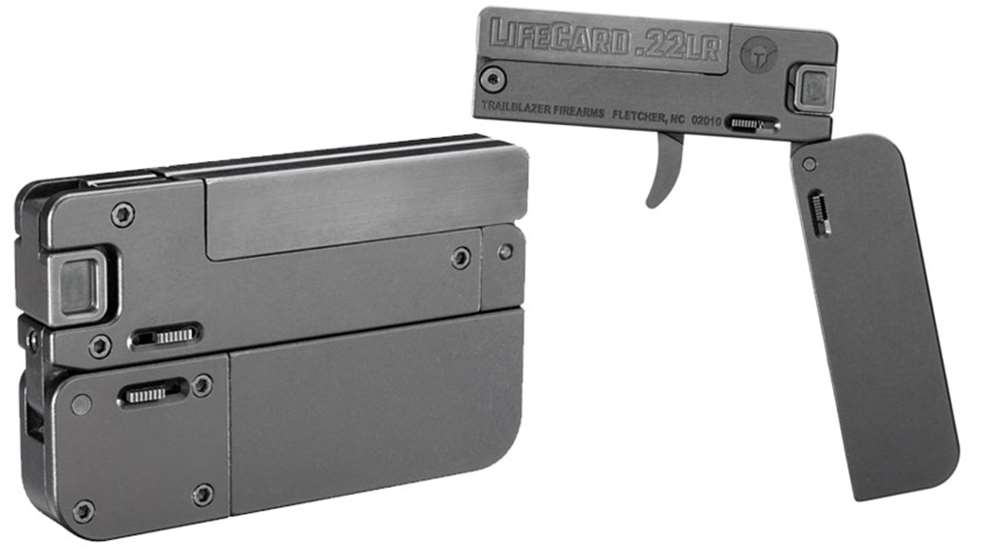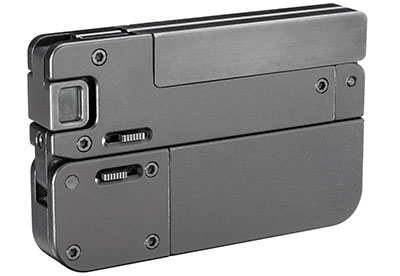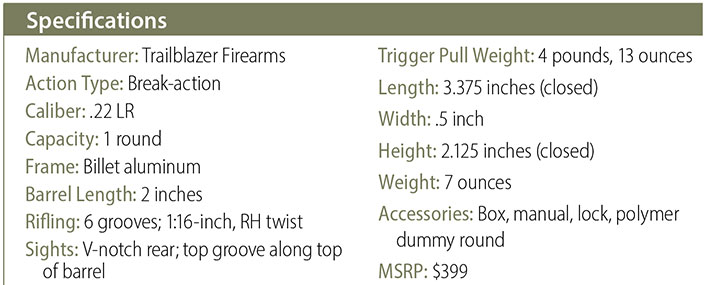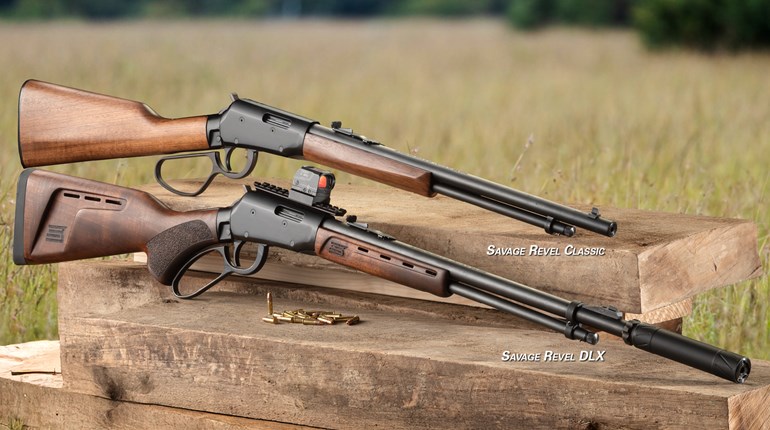

I have been carrying concealed handguns on a near-daily basis since the early 1990s. Different environments and needs have dictated that my carry guns vary in size from guns that are barely guns all the way up to full-size, duty pistols. Now I truly love a good fighting handgun—one that points naturally, fits my hand fully and that I can put several hundred rounds through without needing an orthopedic surgeon afterward. Yet, I am a total sucker for easily concealable handguns. The smaller and stranger they are, the more they interest me. The Trailblazer Firearms LifeCard fits squarely into the latter category.
The LifeCard is a single-shot, .22 LR handgun that employs a single-action, striker-fired system similar to that of the World War II-era, .45 ACP Liberator designed for the OSS. Depending on your generational perspective, the LifeCard is about the size of either a cellular hotspot device or an oversize Zippo lighter. Trailblazer advertises that it is the size of a stack of credit cards and while that is true, that stack will be about 17 cards thick when the LifeCard is folded into its smallest dimensions. Still, the gun’s small size and nondescript shape make it easy to hide. Even if it does print through a pocket, you are far more likely to be asked about your hotspot than your pistol.
But, carrying this little hideout gun discreetly is the easy part of the equation. Actually getting it into operation quickly and smoothly is another story all together. The LifeCard’s manual explains its simple operation clearly, but there is a big difference between being uncomplicated—which it is—and being easy to operate quickly—which it is not.

The manual also stresses that the LifeCard should never be carried with a live cartridge in the chamber. That knocks this firearm out of the backup gun category in my opinion, relegating it to more of a backpack, survival kit or tackle-box status, where the relatively slow process of loading and getting the LifeCard into operation is less of an issue.
Loading and firing the LifeCard is pretty much a two-handed affair. The handgun’s striker mechanism—which the company calls the bolt—must be in the half-cock position for the gun to be folded, unfolded, loaded or unloaded. You begin the unfolding process by first grasping a small, spring-loaded latch on both sides of the bottom half of the LifeCard. The latch is similar to the sliding lock used to remove a Glock-type pistol’s slide. Pushing the latch forward allows the lower half of the pistol to rotate down into a locked, angled, grip position. A guardless trigger is thus exposed, protruding down from the LifeCard’s upper half. Loading the pistol requires a similar latch on the top half of the gun to be pulled rearward, allowing you to tip up the hinged barrel for breechloading a single .22 LR cartridge. The barrel’s spring-loaded latch is again pushed forward to lock the barrel closed for firing. The bolt’s exposed rear gripping surface may then be fully retracted, cocking the LifeCard.
Once fully cocked, should the striker somehow release without the trigger being pulled, it will stop at the half-cock position, locking the trigger and preventing the LifeCard from firing. If you cock the bolt and decide not to shoot, it can be returned to the half-cock by maintaining control of it after carefully releasing it with the trigger and then releasing the trigger while “lowering” the bolt to half-cock. The process is similar to the way one would decock a revolver. Like most other rimfires, the LifeCard should not be dry-fired on an empty chamber. The included dummy round or a spent case can be loaded for this purpose.

I found the LifeCard to be reasonably accurate at distances where one would be most likely to use a last-ditch handgun. The trigger on my test gun broke crisply and felt recoil was almost nonexistent. At 10 feet, my point-of-impact was 4 inches high when firing Winchester Wildcat 40-grain ammo and 6 inches high, 2 inches right with Federal Premium American Eagle 40-grain loads. Groups consisted of 2- to 3-inch clusters and an inevitable flyer that opened up to 5 or 6 inches. I blame my inability to be consistent with the sighting groove for those odd shots outside the main groups. I did not shoot the usual test protocol because accuracy is pretty much minute-of-torso beyond the 10 foot mark. At 15 feet there were no discernible groups and at 20 feet, half the rounds fired were completely off a full-size FBI “Q” silhouette.
Unloading or reloading require setting the bolt back to half-cock, then pulling the barrel latch to the rear to again tilt it up, exposing the chamber. Spent cases are removed via the trusty fingernail-under-the-rim method. I also learned the hard way that if you get too aggressive while opening the sliding cover, it will come right off of the grip half of the gun. Fortunately the spring-loaded detent that should have held the cover in place stayed in the grip when this happened to me. The latch cover slid easily back onto its track, allowing the detent to be re-seated. Placing the LifeCard back into its closed configuration requires the bolt to again be half-cocked, then reversing the process of opening it up.
Obviously there are tiny handguns better-suited for backup purposes. For example, the smallest of the North American Arms mini-revolver family is close in size to the LifeCard. But, it holds five rounds of .22 LR ammunition, can be carried safely while loaded, operated with one hand and is reasonably accurate at defensive-shooting distances. Still, the LifeCard is shorter, thinner, slightly lighter and does not look like a firearm when folded. So if storage in the smallest of spaces is the chief consideration, Trailblazer’s LifeCard wins.







































